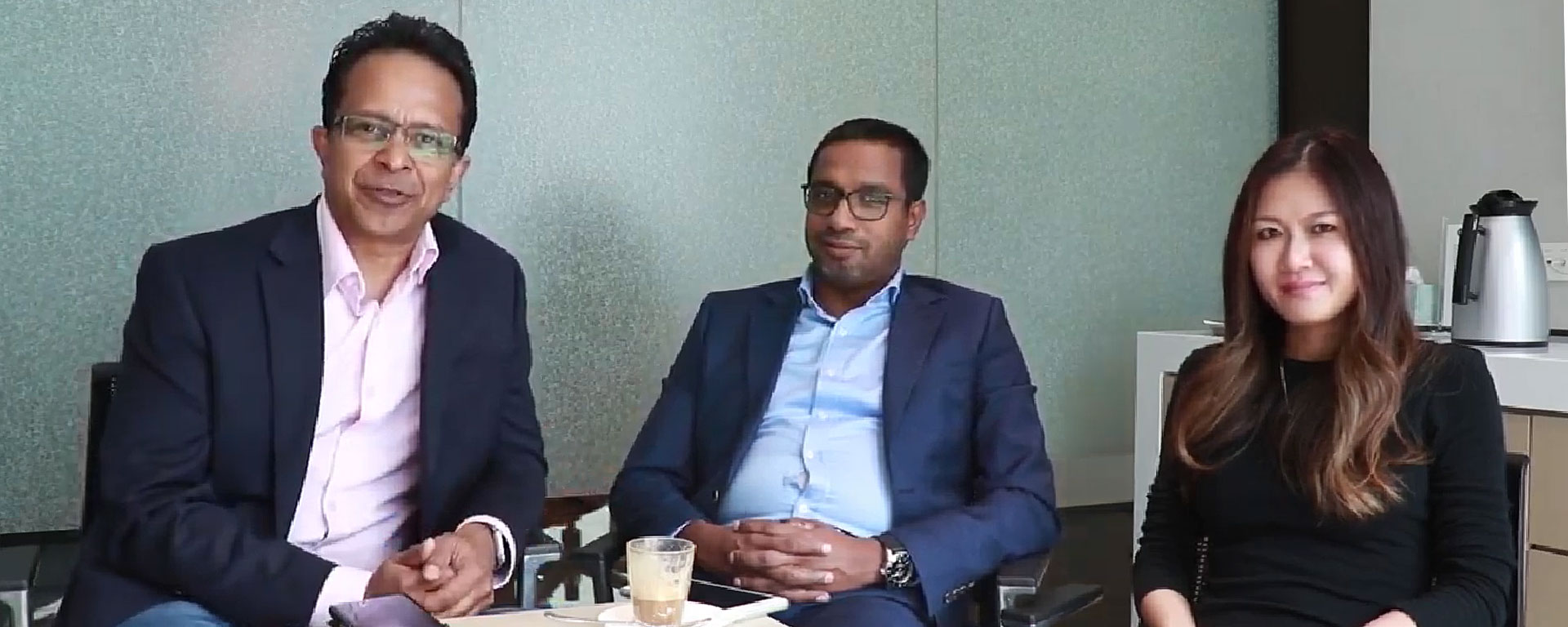Since the big Federal Budget announcement on the 2nd April 2019, a multitude of small business owners has submitted their questions to us in regard to the $30,000 instant asset write-off. To help answer all your questions about the instant asset write off 2019, today Dinesh is joined by two experts; Raj Deepan and Mia Ni from globally renowned accounting and consulting firm Grant Thornton, to discuss on this hot topic for small businesses.
Watch below: Dinesh’s interview with Grant Thornton on the $30,000 Instant Asset Write-off.
(Left to Right): Dinesh De Silva, Raj Deepan (Partner at Grant Thornton) and Mia Ni (Senior Manager at Grant Thornton)
Q. Let’s hear about Grant Thornton. Would you mind telling us a bit about Grant Thornton Raj?
Raj: Yes sure Dinesh. So Grant Thornton is a global accounting firm. We are in 130 countries, and about 50,000 people globally. In Australia, we are in all the states, about 1400 people. And we focus on providing mid-sized businesses with advisory services to help them grow and scale their business.
Q. Now, would you mind telling us what type of businesses are eligible for this grant?
Mia: Sure. To be eligible for this grant, generally, you’ll need to be a small business with an aggregate turnover of less than 10 million. This applies for the period of 1 July 2016 all the way till 30 June 2020. However, the good news is that part of the reason to budget measure, the government has extended this eligibility to some of the medium-sized business with a turnover of less than $50 million, and this applies from the budget night which was 2nd April 2019 all the way to 30 June 2020.
Raj: And just to come in there, the reason behind that is that the Government sees the mid-sized business or small to mid-sized business as the growth engine of the Australian economy and they’re encouraging business obviously to invest to grow the economy. So I think it’s a great initiative by the government to actually extend it from 10 million to 50 million.
Dinesh: And all these investments are really targeted at growing the economy and growing jobs?
Raj: Absolutely and I think that’s the strategy because obviously, Australia does require tax reforms in the long term but as part of the strategy we need to grow our tax base and that strategy is given really easy to grow the economy which internally can help bring tax rates down in the future.
Q. What type of assets are eligible for this?
Mia: To be eligible, generally it needs to be a tangible depreciating asset for example car that’s used for business, or printer, a laptop, etc. However, IPs for example patents or registered designs and the licenses for those are also eligible in addition in-house software are also eligible for the write-off.
Dinesh: So if somebody buys some software or invest in building their web platform or website, those are eligible assets?
Mia: That’s correct, as long as they’re the keyword is in house, as long as its for their business use, then yeah you’ll be eligible
Dinesh: Fantastic and that’s a really good point. So as long as these assets are bought to be used for their business as opposed to for their private use or for sale, they’re eligible?
Mia: That’s correct. They can’t be a stock, it can’t be a trading stock, so yes generally I’d say most of those tangible assets are eligible.

Your first step to building a world-class website starts here.
A trusted brand is priceless for any business. We will help you build a compelling website that is respected in your industry and stands apart from your competition.
Q. I’m earning a profit of $30,000 or $50,000, how does it work? Say a business has a profit of $50,000 this financial year, how does it work?
Raj: To answer that, the tax rate for that business will be 27.5%, so they’ll only pay about a third of that profit in tax, so about $15,000 in tax. By claiming the instant asset write-off, you’re saving effectively, let’s say $20,000 is what you’ve spent, then on that, you’ll be saving your 30% tax or 27.5% tax, which reduces your tax liability by $6000. So effectively it gives you an immediate tax saving, which the idea is that then you can utilise that money to deploy in your other parts of your business.
Dinesh: Fantastic, so if I buy an asset for say $25,000, and my profit is $50,000, so my tax liability goes down to $25,000?
Raj: So it depends on whether you’re entitled to the $20,000 or $30,0000 concession. Assuming its $20,000, so you’d say your profit is $50,000, then write off of $20,000, so your revised profit is $50,000 minus $20,000 which is $30,000, and then you pay tax on the $30,000.
Dinesh: Alright. So just to keep it simple Raj, say from now on, so assume today is the 15th April, and I buy or any business buys an asset for $25,000, but their profit for that financial year is $50,000, so their tax liability becomes or taxable income is what?
Raj: Mia you can answer that right in terms of when you buy an asset for $25,000 but there is a limit to $30,000.
Mia: If the asset is purchased today and installed ready for use, then I believe that the $30,000 limit will apply because we’ve passed the budget night. And then if that’s the case, then your taxable profit will be reduced to $25,000. And essentially, you reduce your tax bill by the applicable tax rate of 27.5% on the $25,000.
Raj: So that’s about $8,000 I think. So that’s a taxable saving of $8000
Q. There have been multiple announcements by the government correct and the recent announcement was made into Law if I’m not wrong. Was it on the 6th of April?
Mia: Yes, it received the Royal Assent on 6th of April, therefore it is legislated
Dinesh: Legislated. So fantastic news guys so, the $30,000 tax instant tax write-off is available of the 6th April. So if you have a profit of $50,000, and you buy something for say $25,000, then your tax liability is the balance $25,000, and then whatever tax is calculated as Raj said, about $8000 would be your tax saving.
Mia: That’s correct
Raj: Tax saving. That’s correct
Q. What happens if they buy an asset that has 50% business use and 50% personal use?
Mia: That’s a really good question. Only the business portion is eligible for the instant asset write-off, so for example, if that asset purchased was let’s say $20,000, only $10,000 is eligible for the write-off because the other 50% is used privately. One thing, very important that we would like to point out is that the total cost of the asset needs to be under the threshold, so for example, if on 1 June 2019, you’ve purchased an asset for let’s say $40,000 and used it 50% for business. Then because even though the business portion is only $20,000, technically it’s under the threshold, because the entirety of the cost of the asset is over the $30,000 threshold, unfortunately, it won’t be eligible.
Dinesh: It won’t be eligible. Alright, so thank you
Raj: So the critical number is $30,000, respective of the business or private use, to qualify, you have to be under the $30,000
Q. If I buy an asset for $30,000, does that need to be inclusive of GST or can it be exclusive of GST? Mia, what are your thoughts on that?
Mia: It depends. For most businesses, I’d think they’d be registered for GST. So if you are registered for GST, you would have already claimed the GST paid on the asset in the business activity statement for the relevant period. So in that case, the threshold is actually GST exclusive.
Dinesh: Fantastic
Mia: However in some limited situation where you’re not registered for GST because you’re under the threshold, then the $20,000 or $25,000 instant asset write-off threshold will be GST inclusive.
Q. So, for those businesses who are not paying GST or not registered for GST must consider that the GST component is included in the purchase of the asset. Would that be a fair statement?
Mia: Yes, that’s correct
Raj: So just to clarify Dinesh right. You’re saying the company is registered for GST,
Dinesh: No, if the company is not registered
Raj: Ah no it’s not registered for GST, then that’s correct.
Dinesh: If the business is not registered for GST and if you buy an asset, then we’ll need to make sure that the asset is inclusive of GST is under the threshold
Raj: Yep, that’s correct. And you’ll find that most businesses are registered, small businesses are registered for GST. The situations that you won’t be registered in GST is if you are in health services, or you’re in primary food, you know you sell fruit and vegetables. So there are limited exemptions where small businesses will not be registered for GST. In most cases, you will be expected to be registered for GST, in which case your threshold is $30,000 plus the GST. So the total budget could be $33,000. After GST your purchase would be $30,000 and you will qualify.
Q. What happens if a company is making a loss. So this financial year business is making a loss of say $50,000, and they buy an asset for $30,000. What happens then?
Mia: So instant asset write off actually increases the losses, and those losses can be used to carry forward indefinitely to offset against future taxable income provided certain company loss measurements are met. I would like to point out that it’s an instant asset write off, it’s not a straight-out tax refund, so if you are making a loss, that does add to the loss pool in a way. But there won’t be a cash refund.
Q. A lot of people are confusing the instant asset write-off as a rebate. This is not a rebate. Is it?
Raj: That’s right. It’s not a rebate. It reduces your tax liability, so it’s not a refundable offset or refundable rebate. So if you have a tax liability, reducible liability, if you have a tax loss in which you don’t have a tax liability, you’re just carrying forward those losses to be claimed in the next year.
Q. For those businesses that are making a loss, and you buy an asset for $25,000 as long as you have the cash flow to do that, is there an advantage in increasing your loss, because in future years you can write that off from your profits?
Raj: Yes so you can look at it. One is obviously getting your GST back, with GST you get that back straight away. In terms of the loss, especially if your expected your forecast indicates you can make a profit next year, it doesn’t make sense. Because the alternative of not claiming the instant asset write off is to claim the depreciation asset over several years, it could be 3 or 4 years. So to get the same benefit it’s going to take 4 years. Whereas in the forecast make a profit of let’s say in the 2020 year the following year, it makes sense to incur a loss before June this year, then offset that profit in the next year.
Q. Is this instant tax write off only available for one asset each year?
Mia: No, it actually applies to multiple assets. In fact, as many assets as a business can buy, so as long as each individual asset costs less than the threshold the business can continue to use the instant asset write off.
Raj: So let me elaborate on that right. So say you go an buy some computers, assuming its expensive computers and the bill is $50,000, and you get the bill from Dell for some fancy computers. You actually look at the bill, it’s got three servers in there. Each of them cost less than the $30,000, or each costing under the limit. In which case you apply, you’re able to claim from the instant asset write-off for each of them. You look at the component of the bill. As long as they’re discrete assets, then you can apply for each discrete asset.
Q. Another question that is constantly asked is, do these assets have to be brand new?
Mia: No, it can be second hand as long as they are used for business and that they’re under the threshold.
Q. Now the most confusing thing about this instant asset write off is that there have been multiple announcements by the government. I believe there have been three. So I’m going to ask Mia to explain how that works.
Mia: So the original instant asset write off threshold was $20,000 and it applied from 1 July 2016 to 30 June 2019. However back in January this year, the Morrison Government announced they’re going to increase the threshold to $25,000 and extend the instant asset write off till 30 June 2020. And then once again, on budget night, the Morrison Government increased the write-off threshold to $30,000, with the extended application date to 30 June 2020. In addition, they’ve expanded the eligibility criteria to make the medium-sized businesses to be eligible for that as well. So basically in 2019 financial year, we’re dealing with 3 different thresholds:
- 1st July 2018 to 28th January 2019 – the threshold is $20,000.
- From 29th January to budget night 2nd April 2019 the threshold is $25,000.
- And from 2nd April to 30 June 2020 as it stands, it’s going to be $30,000.
Raj: So any asset purchased between now and the 30th June 2020, you’re basically in the $30,000 category.
We would like to thank Raj Deepan and Mia Ni from Grant Thornton for taking the time today to answer the questions for our clients and other small business owners. We hope this interview gives you a better understanding of the $30,000 Instant Asset Write off. If you have any further inquiries regarding this tax scheme, make sure to forward them to our email address at bc@netstripes.com, or call us at 1300 10 8880.
Don’t forget to check out our blog post on our 3 wise innovative investments you should consider for the $30,000 instant asset write off 2019.
Our web solutions are eligible for the $30,000 Instant Asset Write-off! With the end of the financial year looming upon us, don’t miss this opportunity to get a professional and modern website for your business, so you can win more customers before the EOFY.
Are you ready to elevate your business to another level?
Are you ready to elevate your business to another level?
If you would like to have your digital marketing strategy aligned with your business’ objectives and goals, book a consultation with one of our Digital Strategists at Netstripes here.
Our digital specialists with years of marketing experience will be able to advise and propose a digital marketing solution with supportive inbound strategies (including website development) and affordable outbound strategies. Find out which marketing strategy is suitable for your business!
Feel free to talk to one of our digital strategists today. We are more than happy to help!
Contact us now.



